![]()
Aroids and other genera in the Collection
Take the Tour Now?
Orchids
The
Exotic Rainforest
Plants in
the Exotic Rainforest Collection
The images on this website are copyright protected. Please contact us before any reuse.
Within our collection we have many species of Philodendron.
If you are seeking other photos,
click this link
Philodendron pusillum
E. G.
Gonçalves
& J. Bogner
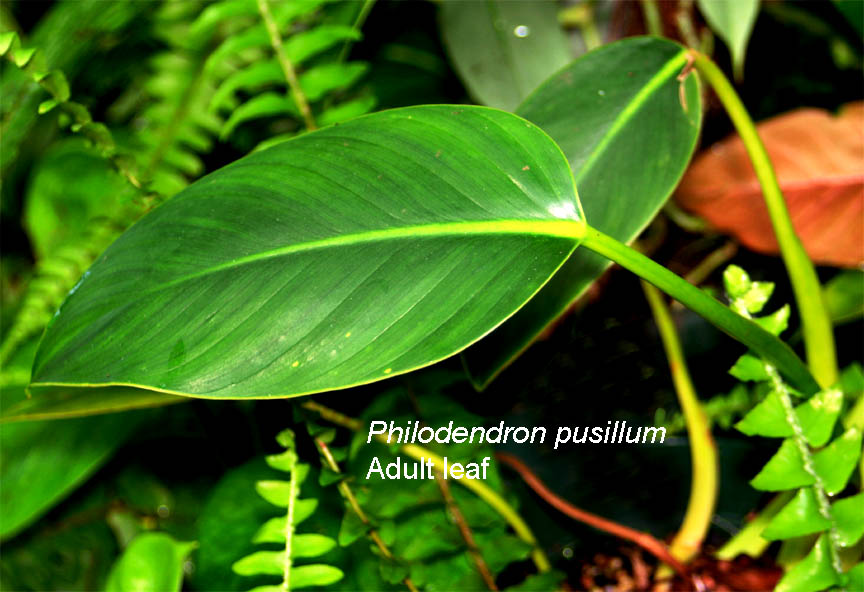
Philodendron pusillum
E. G.
Gonçalves
& J. Bogner
One of the world's smallest
Philodendron species.
The scientific material in this article was extracted from the published scientific description of Philodendron pusillum by Dr. Eduardo Gonçalves and Dr. Josef Bogner. Many of the photos of our specimen have been reviewed by Dr. Gonçalves. The specimen in all the photos on this page now resides in the collection of the Missouir Botanical Garden as specimen number C.101529.
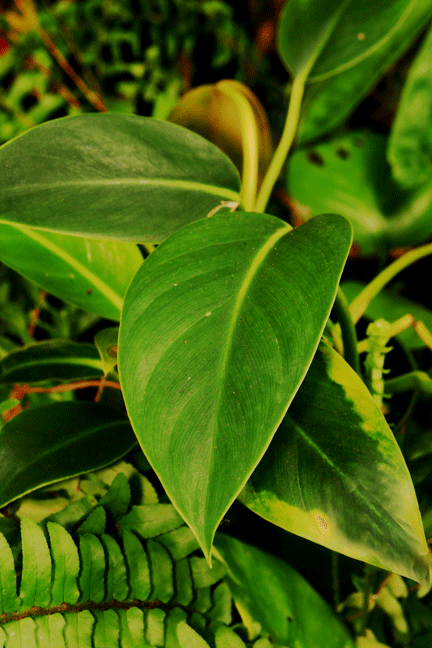 Published to science in 2004,
Philodendron pusillum (pew-SIL-lum) is found endemically (exclusively) in the lowlands
of south central Colombia relatively near the border with Brazil.
Philodendron pusillum
is one of the smallest
Philodendron
species known to science and
is somewhat similar to
Philodendron humile which is found endemically near Acre, Brazil. Acre is substantially closer to
Peru than to Colombia.
Philodendron humile is also a very small
species and was also published by Dr. Gonçalves. The major
difference in Philodendron pusillum
and Philodendron humile is the
later has cordate (heart shaped) leaf blades. The name "pusillum"
indicates a
small leaf. At this writing P. pusillum
is considered quite rare in private as well as in public collections.
Published to science in 2004,
Philodendron pusillum (pew-SIL-lum) is found endemically (exclusively) in the lowlands
of south central Colombia relatively near the border with Brazil.
Philodendron pusillum
is one of the smallest
Philodendron
species known to science and
is somewhat similar to
Philodendron humile which is found endemically near Acre, Brazil. Acre is substantially closer to
Peru than to Colombia.
Philodendron humile is also a very small
species and was also published by Dr. Gonçalves. The major
difference in Philodendron pusillum
and Philodendron humile is the
later has cordate (heart shaped) leaf blades. The name "pusillum"
indicates a
small leaf. At this writing P. pusillum
is considered quite rare in private as well as in public collections. A
slow growing species, Philodendron pusillum was described to science by botanists Dr.
Eduardo
Gonçalves
and Dr. Josef Bogner as a small terrestrial aroid which grows on the
forest floor,
Philodendron pusillum
has been placed in
Philodendron
subgenus
Philodendron.
The genus
Philodendron
is divided into three subgenera including subgenus
Philodendron, subgenus
Meconostigma and subgenus
Pteromischum. These subgenera are
further divided into sections as well as subsections based on the specific
characteristics of a species.
As explained in the scientific description for
Philodendron pusillum,
"The
Neotropical genus Philodendron is very variable, comprising woody shrubs to
herbaceous climbers. It is divided into three subgenera, and the largest, P. subg.
Philodendron, to which our new species belongs, is again divided into
several sections (Croat 1997)."
The sectional placement of
Philodendron pusillum
has yet to be determined.
A
slow growing species, Philodendron pusillum was described to science by botanists Dr.
Eduardo
Gonçalves
and Dr. Josef Bogner as a small terrestrial aroid which grows on the
forest floor,
Philodendron pusillum
has been placed in
Philodendron
subgenus
Philodendron.
The genus
Philodendron
is divided into three subgenera including subgenus
Philodendron, subgenus
Meconostigma and subgenus
Pteromischum. These subgenera are
further divided into sections as well as subsections based on the specific
characteristics of a species.
As explained in the scientific description for
Philodendron pusillum,
"The
Neotropical genus Philodendron is very variable, comprising woody shrubs to
herbaceous climbers. It is divided into three subgenera, and the largest, P. subg.
Philodendron, to which our new species belongs, is again divided into
several sections (Croat 1997)."
The sectional placement of
Philodendron pusillum
has yet to be determined. 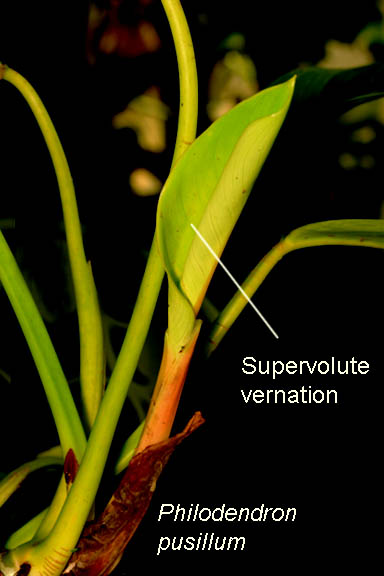 With almost rubbery coriaceous
(leather-like) leaves, Philodendron pusillum grows terrestrially.
A fully adult specimen only
reaches a height of approximately 30 to 35
cm (12
to
13.75 inches). Growing slowly in clusters with adjoining stems the
species produces approximately 4
to 7 leaves per plant with the
blades lanceolate to elliptic-oblong in shape. A lanceolate leaf
blade is shaped like the knife-like weapon known a lance while a blade that
is both elliptical and oblong may possess wider leaves. The leaf
blades open from the cataphyll in a supervolute fashion which is similar to
convolute vernation. Supervolute has one leaf margin (edge)
rolled inward with the opposite margin rolled around it whereas convolute
has both margins rolled in the same direction around the midrib and around
itself. (see photo, right)
With almost rubbery coriaceous
(leather-like) leaves, Philodendron pusillum grows terrestrially.
A fully adult specimen only
reaches a height of approximately 30 to 35
cm (12
to
13.75 inches). Growing slowly in clusters with adjoining stems the
species produces approximately 4
to 7 leaves per plant with the
blades lanceolate to elliptic-oblong in shape. A lanceolate leaf
blade is shaped like the knife-like weapon known a lance while a blade that
is both elliptical and oblong may possess wider leaves. The leaf
blades open from the cataphyll in a supervolute fashion which is similar to
convolute vernation. Supervolute has one leaf margin (edge)
rolled inward with the opposite margin rolled around it whereas convolute
has both margins rolled in the same direction around the midrib and around
itself. (see photo, right)P. pusillum may also produce a reduced foliar leaf which is simply a blade that never matures and perpetually remains small (photo left, below). The blades are acuminate which indicates they taper to a point at the apex and measure approximately 13 to 20 cm (5 to 7 inches) long by 2.4 to 4.5 cm (1 to 1 3/4 inches) in width. The upper blade surface is known in science as the adaxial surface while the lower surface is known as the abaxial side of the blade.
Within aroids and other plant species the veins on a leaf have specific
names. The most
prominent veins on
Philodendron pusillum are the
midrib, primary lateral leaf
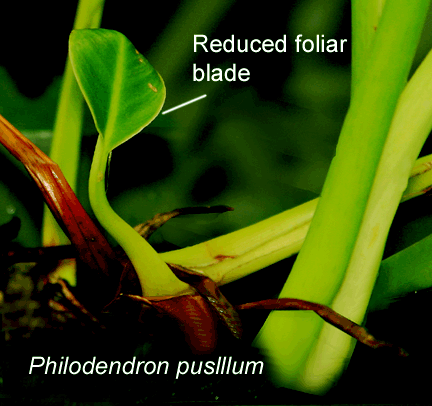 veins and interprimary or secondary veins. The minor veins are known as
the tertiary
veins. The venation
(veins) of Philodendron pusillum is considered to be both parallel
and pinnate. Parallel indicates the veins run
roughly
side by side while pinnate indicates they are formed similar to the
arrangement of the fronds of a palm. In Philodendron pusillum
that indicates they emerge from the midrib at the center of the leaf (see
photo, above left) in a parallel fashion progressing towards the blade's
margin (edge). Philodendron pusillum
possesses 4 to 5 primary lateral veins on each side of the midrib that extend
from the rib toward the margin at an angle of 20 to 30
degrees. There are also 3 to 6 substantially thinner secondary veins
which can be found situated between the primary lateral veins. In
addition there are numerous much finer tertiary (minor) veins situated
between the secondary veins (see photo right, below). The veins are
more easily observed on the abaxial surface (underside) of the
blade.
veins and interprimary or secondary veins. The minor veins are known as
the tertiary
veins. The venation
(veins) of Philodendron pusillum is considered to be both parallel
and pinnate. Parallel indicates the veins run
roughly
side by side while pinnate indicates they are formed similar to the
arrangement of the fronds of a palm. In Philodendron pusillum
that indicates they emerge from the midrib at the center of the leaf (see
photo, above left) in a parallel fashion progressing towards the blade's
margin (edge). Philodendron pusillum
possesses 4 to 5 primary lateral veins on each side of the midrib that extend
from the rib toward the margin at an angle of 20 to 30
degrees. There are also 3 to 6 substantially thinner secondary veins
which can be found situated between the primary lateral veins. In
addition there are numerous much finer tertiary (minor) veins situated
between the secondary veins (see photo right, below). The veins are
more easily observed on the abaxial surface (underside) of the
blade.
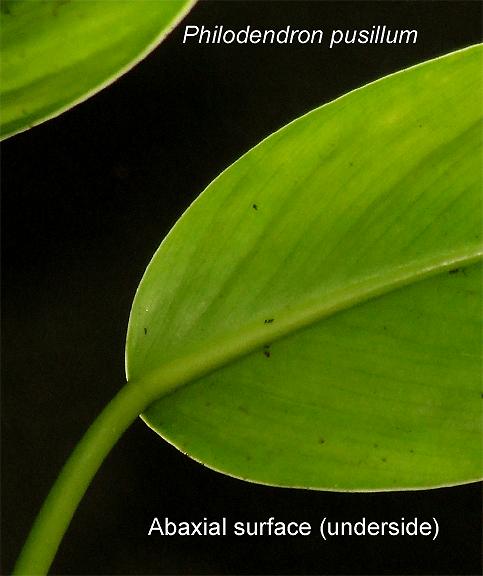 The stalks that support the leaves are known as petioles.
Despite common misconceptions the petiole is not
the "stem" which is a term commonly used incorrectly by plant
collectors. The petiole connects the lamina of the leaf
blade at the petiole's top to the actual stem at its bottom. The
shape of the petioles of our specimen of P. pusillum are round
(terete) to "C" shaped with a canaliculate upper surface. Canaliculate indicates
the plant has a sulcus or
canal-like depression running along the petiole's axis.
The stalks that support the leaves are known as petioles.
Despite common misconceptions the petiole is not
the "stem" which is a term commonly used incorrectly by plant
collectors. The petiole connects the lamina of the leaf
blade at the petiole's top to the actual stem at its bottom. The
shape of the petioles of our specimen of P. pusillum are round
(terete) to "C" shaped with a canaliculate upper surface. Canaliculate indicates
the plant has a sulcus or
canal-like depression running along the petiole's axis. (your plant) is cultivated a little change
is expected." The roots of
Philodendron pusillum are reddish as well as stiff. The roots are
are numerous on the lower
portion of the stem.
(your plant) is cultivated a little change
is expected." The roots of
Philodendron pusillum are reddish as well as stiff. The roots are
are numerous on the lower
portion of the stem. The petioles grow from a bud on the stem and transfers water along with nutrients from the stem to the leaves. The blades then convert carbon dioxide in the air into oxygen for other living organisms such as rain forest animals to breathe The petioles of Philodendron pusillum are typically reddish but may be expected to vary in color in cultivated specimens. As can be observed in our specimen very little red is visible directly on the stem but is enhanced as the specimen matures.
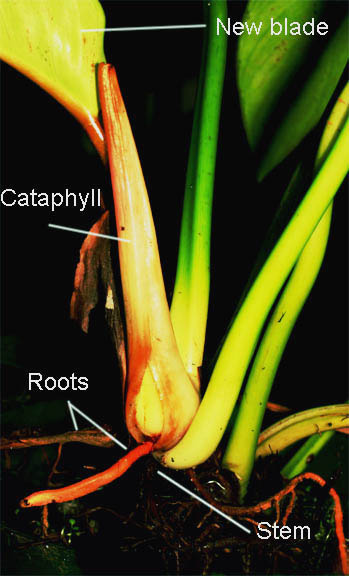 When
a new leaf and petiole begin to emerge from a bud at the stem it is
surrounded by a bract-like modified leaf known as a cataphyll. The
cataphyll is the singular most important identifying characteristic of an
aroid. The purpose of the
cataphyll is to protect the new leaf as it
develops. The cataphylls first emerge as a light green but turn
reddish and become somewhat "papery" as they age.
When
a new leaf and petiole begin to emerge from a bud at the stem it is
surrounded by a bract-like modified leaf known as a cataphyll. The
cataphyll is the singular most important identifying characteristic of an
aroid. The purpose of the
cataphyll is to protect the new leaf as it
develops. The cataphylls first emerge as a light green but turn
reddish and become somewhat "papery" as they age. We have observed the cataphylls of Philodendron pusillum to be double keeled (two
 ribbed) but the ribs are not always obvious until
the cataphyll begins to change coloration. The cataphylls are also
membranaceous. I asked Eduardo to
explain,
"Membranaceous
means with the consistence of a membrane, i.e. like a piece of your shirt.
It is the opposite of coriaceous that is like a piece of leather".
A double keeled petiole is typical of species that have a sympodial growth
form. The cataphylls of P. pusillum persist on the stem as dried material once the blade
emerges and is fully developed. (see photo below).
ribbed) but the ribs are not always obvious until
the cataphyll begins to change coloration. The cataphylls are also
membranaceous. I asked Eduardo to
explain,
"Membranaceous
means with the consistence of a membrane, i.e. like a piece of your shirt.
It is the opposite of coriaceous that is like a piece of leather".
A double keeled petiole is typical of species that have a sympodial growth
form. The cataphylls of P. pusillum persist on the stem as dried material once the blade
emerges and is fully developed. (see photo below). All Philodendron species are members of the larger plant family known as Araceae and are commonly known as aroids. An aroid is a plant that reproduces via the production of an inflorescence which consists of two distinct parts known as the spathe and spadix as well as the peduncle which provides support. Other near microscopic parts including the sexual parts are known as the male, female and sterile flowers as well as anthers, stamens, stigma and pollen when the plant is in the reproductive process.
Many people believe the spathe is a "flower" which is incorrect. The spathe is a modified leaf whose purpose is to protect the spadix at the center of the inflorescence during its sexual development. The spadix is a spike on a thickened fleshy axis which can produce tiny flowers. When sexually mature tiny flowers can be found along the spadix but the spathe itself is not a flower.
 Aroids
have two basic reproductive groups. One produces a
bisexual inflorescence with male and female flowers mixed together
along the length of the spadix while the other is
the unisexual
group and includes those aroids that produce an inflorescence with separate
flower zones.
Aroids
have two basic reproductive groups. One produces a
bisexual inflorescence with male and female flowers mixed together
along the length of the spadix while the other is
the unisexual
group and includes those aroids that produce an inflorescence with separate
flower zones.
Philodendron species are unisexual and the female flowers are cleverly hidden inside the lower portion of the spathe in a closed chamber known as the floral chamber. At female anthesis when the plant is ready to reproduce the spadix produces female flowers for a very short period of time (normally one day) near its base. They are followed by male flowers which will produce pollen but normally for only a single day. In Philodendron species the female flowers are produced on the first day followed (normally) by the male flowers on the second. The sterile flowers are also hidden inside the floral chamber just above the female flowers and are a primary attractant to insect pollinators since they are responsible for the production of an attracting pheromone (perfume). The sterile flowers are used as food by pollinating beetles since they contain proteins in the form of lipids. The male flowers are separated in a zone higher on the spadix in order to prevent self pollination. All the flowers are very small and almost microscopic.
If the
female flowers are pollinated by an appropriate insect which is normally a
beetle from the genus
Cyclocephala that carries
pollen from another specimen currently at male anthesis the spadix will
be pollinated and begin to grow berries
(fruits) which eventually contain seeds. The berries are eaten by rain
forest animals and birds and are scattered about the forest in their
droppings.
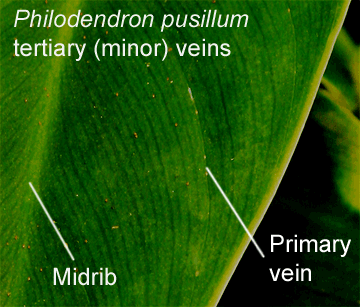 spadix at its center is only 3.5 to 4 cm
(1.4 to 1.575 inches) long and grows on a stipe 5 to 6 mm (less than 1/4
inch) long. A stipe is simply a stalk which grows between
the spadix and the spathe itself. The color of the fruits produced
once pollinated has not been observed or reported in scientific literature.
spadix at its center is only 3.5 to 4 cm
(1.4 to 1.575 inches) long and grows on a stipe 5 to 6 mm (less than 1/4
inch) long. A stipe is simply a stalk which grows between
the spadix and the spathe itself. The color of the fruits produced
once pollinated has not been observed or reported in scientific literature. For more information on aroid pollination please read this article by aroid expert Julius Boos. Aroid pollination
Our specimen was a gift in 2006 from Florida aroid grower Russ Hammer. My thanks to aroid botanist Pete Boyce in Malaysia for directing me to the correct correct scientific name for the plant shown on this page. Additionally, my deep thanks to Brazilian aroid botanist Dr. Eduardo Gonçalves for examining my photographic material and providing his opinion of the identification of this specimen. Both of these experts have frequently been kind to answer my questions and provide valid botanical information.
The specimen shown in all of the photos on this page now resides in the collection of the Missouri Botanical Garden as specimen number C.101529.
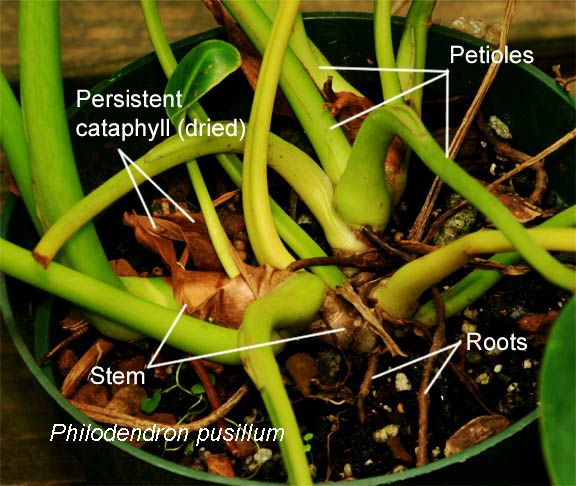
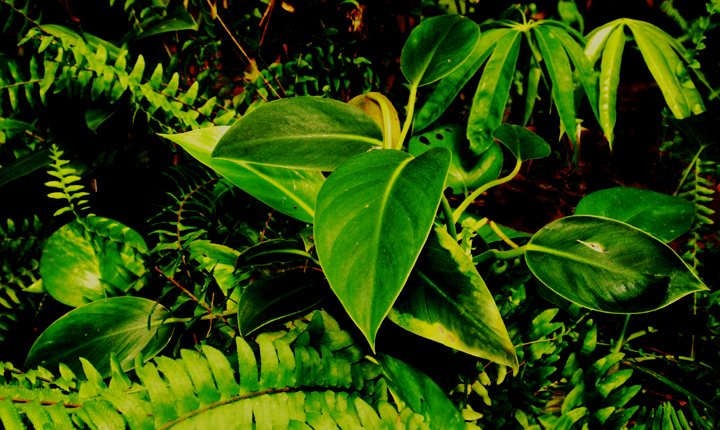

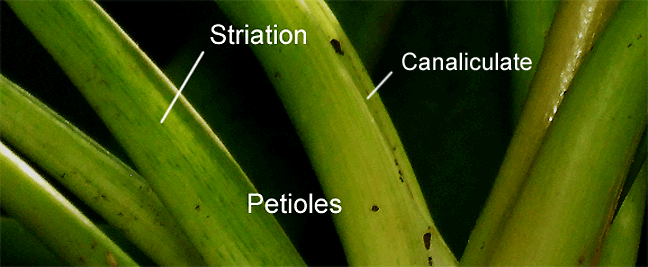
Join the International Aroid Society:
http://www.exoticrainforest.com/Join%20IAS.html